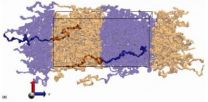(Press-News.org) ALBUQUERQUE, N.M. — Sandia National Laboratories researcher Steve Plimpton, who led development of a widely used computer code that models how materials behave, has been invited to present a keynote lecture at the Feb. 27-March 3 Minerals, Materials & Materials Society (TMS) meeting in San Diego.
Plimpton developed the LAMMPS molecular-dynamics software code. The acronym LAMMPS (Large-scale Atomic/Molecular Massively Parallel Simulator) is also a pun on the word "lamp," a device that brings light to dark places.
"This symposium [on Massively Parallel Simulations of Materials Response] will particularly recognize your contribution as the primary developer of one large-scale parallel code, the LAMMPS molecular dynamics simulator, which has been of great help to the technical community, wrote symposium co-organizer and Virginia Tech engineering professor Diana Farkas in her invitation to Plimpton. "As users of LAMMPS, we feel that this contribution really deserves a special recognition."
LAMMPS is an open-source code (lammps.sandia.gov) initially funded fifteen years ago through an industrial Cooperative Research and Development Agreement (CRADA) between Sandia and multiple collaborators. Subsequent additions were supported by Sandia's Laboratory Directed Research and Development program, various Department of Energy (DOE) offices, and currently a recent CRADA focused on modeling nanoparticles in solution. Over the years, more than 100 significant contributions to the code have been made by Plimpton and other Sandia and external researchers.
At the atomic scale, LAMMPS can model soft (biomolecules, polymers) or solid-state (metals, semiconductors) materials. Using a more coarse-grained approach, the program can also model mesoscopic or even macroscopic systems as a collection of interacting particles. Able to run on single processors or multiple parallel processors, the code is designed to be easy to modify or extend with new functionality.
This ease of use has led to some 65,000 downloads since its open-source release in 2004, and more than 1,000 journal articles that have cited the code.
Due to its parallel scalability, LAMMPS often helps benchmark performances of the newest DOE and Department of Defense supercomputers, including the DOE Leadership Computing Facility at Oak Ridge National Laboratory. To benchmark the next-generation LCF computer, which is expected to have a hybrid CPU/GPU [central processing unit/graphics processing unit] design, ORNL is supporting a multi-institutional team, led last year by Sandia researcher Paul Crozier, to extend LAMMPS to run on general-purpose GPUs.
Crozier is a LAMMPS co-developer, as are Sandia researchers Aidan Thompson and Mark Stevens.
A year ago, said Sandia manager John Aidun, the first LAMMPS users' meeting was held at Sandia.
"This bare-bones, invitation-only meeting (due to space limitations) was well attended by enthusiastic users and contributors to LAMMPS," he said. "It demonstrated that the code has become an institution, with at least one DoD lab having discontinued its own code development efforts and now depending on LAMMPS to meet its mission responsibilities."
INFORMATION:
Sandia National Laboratories is a multiprogram laboratory operated and managed by Sandia Corporation, a wholly owned subsidiary of Lockheed Martin Corporation, for the U.S. Department of Energy's National Nuclear Security Administration. With main facilities in Albuquerque, N.M., and Livermore, Calif., Sandia has major R&D responsibilities in national security, energy and environmental technologies, and economic competitiveness.
LAMMPS supercomputer code developer earns special recognition
2011-03-04
ELSE PRESS RELEASES FROM THIS DATE:
Florida Will Contest Involving Ponzi Scheme Funds Settled
2011-03-04
A recent settlement involving the estate of the late Jacksonville financial adviser Wayne McLeod is the latest example of how legal complexities can encroach upon the timely resolution of an estate. At the time of his suicide, McLeod's financial services firm was under investigation by the Securities and Exchange Commission. This investigation revealed that McLeod's alleged financial planning prowess was actually a large "Ponzi" scheme.
A significant portion of McLeod's estate will now be used to repay the defrauded investors. McLeod's wife will keep some of her jewelry ...
Student innovation at Rensselaer Polytechnic Institute could lead to better breast cancer screening
2011-03-04
Troy, N.Y. – Recent research by doctoral student Sevan Goenezen holds the promise of becoming a powerful new weapon in the fight against breast cancer. His complex computational research has led to a fast, inexpensive new method for using ultrasound and advanced algorithms to differentiate between benign and malignant tumors with a high degree of accuracy.
Goenezen, a student in the Department of Mechanical, Aerospace, and Nuclear Engineering at Rensselaer, is one of three finalists for the 2011 $30,000 Lemelson-MIT Rensselaer Student Prize. A public ceremony announcing ...
Rise in Discrimination Class Action Settlements
2011-03-04
According to the Annual Workplace Class Action Litigation Report, the value of class action employment discrimination settlements has gone up substantially over the past year. The report notes that, in 2010, the value of the top ten settlements was $346 million. By comparison, the total value of the ten largest settlements in 2009 was $84.4 million.
The settlement in Velez v. Novartis Corp., a federal case from the Southern District of New York, accounts for over half of this years' total. The case was originally filed in 2004 by Amy Velez and four female coworkers who ...
Texas County Leading the Nation in DNA Exonerations
2011-03-04
Cornelius Dupree Jr. was recently released from prison after DNA testing revealed that he could not have committed the crime. After being convicted of rape and robbery, Dupree was sentenced to 75 years in prison in 1980. He spent 30 years maintaining his innocence. He would have been paroled had he admitted committing the crimes, but he refused. Finally, DNA testing of evidence cleared him of any wrongdoing.
Dupree's story is all too familiar in Texas. Dallas County leads the nation in DNA exonerations. The county has released 21 individuals who were convicted of crimes, ...
College students surveyed on guns on campus
2011-03-04
HUNTSVILLE -- Students from two university campuses in Texas and Washington recently were surveyed on allowing concealed handguns on campus.
According to research led by Dr. Jeffrey Bouffard at Sam Houston State University's College of Criminal Justice, more students were uncomfortable with concealed weapons on campus than those at ease with guns on college grounds. The study will be presented at the Academy of Criminal Justice Sciences Meeting in Toronto this month.
"To date, little effort has been made to assess students' opinions about whether concealed handgun carrying ...
For birds, the suburbs may not be an ideal place to raise a family
2011-03-04
There comes a time in life for every bird to spread its wings and leave the nest, but for gray catbirds, that might be the beginning of the end. Smithsonian scientists report fledgling catbirds in suburban habitats are at their most vulnerable stage of life, with almost 80 percent killed by predators before they reach adulthood. Almost half of the deaths were linked to domestic cats.
Urban areas cover more than 100 million acres within the continental the United States and are spreading, with an increase of 48 percent from 1982 to 2003. Although urbanization affects ...
New findings on drug tolerance in TB suggest ideas for shorter cures
2011-03-04
New findings on how tuberculosis (TB) bacteria develop multi-drug tolerance point to ways TB infections might be cured more quickly.
The study will be published April 1 in the journal Cell. The results identify both a mechanism and a potential therapy for drug tolerance that is induced in the TB bacteria by the host cells they infect.
Currently, TB treatment requires a complex, long-term curative regimen of at least six months, explained the senior author of the study, Dr. Lalita Ramakrishnan, University of Washington (UW) professor of medicine, microbiology and immunology. ...
Global Corporate Travel Agency, Teplis Travel, Recently Attended the Concur Fusion 2011 No Limit Conference in Las Vegas
2011-03-04
Teplis Travel, a premier corporate travel agency, recently attended the Concur Fusion 2011 No Limit conference. Held February 15-18, 2011 at The Cosmopolitan Hotel Las Vegas, this event brought together Concur clients, partners, and employees to exchange ideas and knowledge on products and services available to easily manage corporate travel and expenses.
Fusion 2011 session highlights included:
- Reviewing top expense features companies should be using
- Going global with travel
- Delivering value through integration with suppliers, customers and mobile applications
- ...
Humans give prey the edge in food web
2011-03-04
A new paper by University of Calgary researchers, published today in PLoS ONE, demonstrates the edge given to prey in the "space race" by human activity.
The research was conducted by two University of Calgary students, a University of Calgary Post-Doctoral Fellow and two University of Calgary professors from the Faculty of Environmental Design, Department of Geomatics in the Schulich School of Engineering and the Faculty of Veterinary Medicine. The research looked at how predator-prey interactions and use of space were influenced by human activity.
The team deployed ...
Topshop Announces the Inspiration Behind Their Unique Collection for Autumn/Winter 2011
2011-03-04
Topshop has announced the inspiration behind their autumn/winter 2011 Unique collection
For AW11, Topshop Unique journeys back to early 1930s America. Drawing on the culture of luxury and status of the Industrial Age, prints are bold and boastful and the silhouette is overall sleek and refined.
Prints are key in the collection and the recurring motif of the dog and car reflect the importance of social status during the decade. Automobiles with headlights streaming are appliqued onto down-sized luggage bags, and printed on satin shoes. Whippets, Grey Hounds and Dalmatians ...


